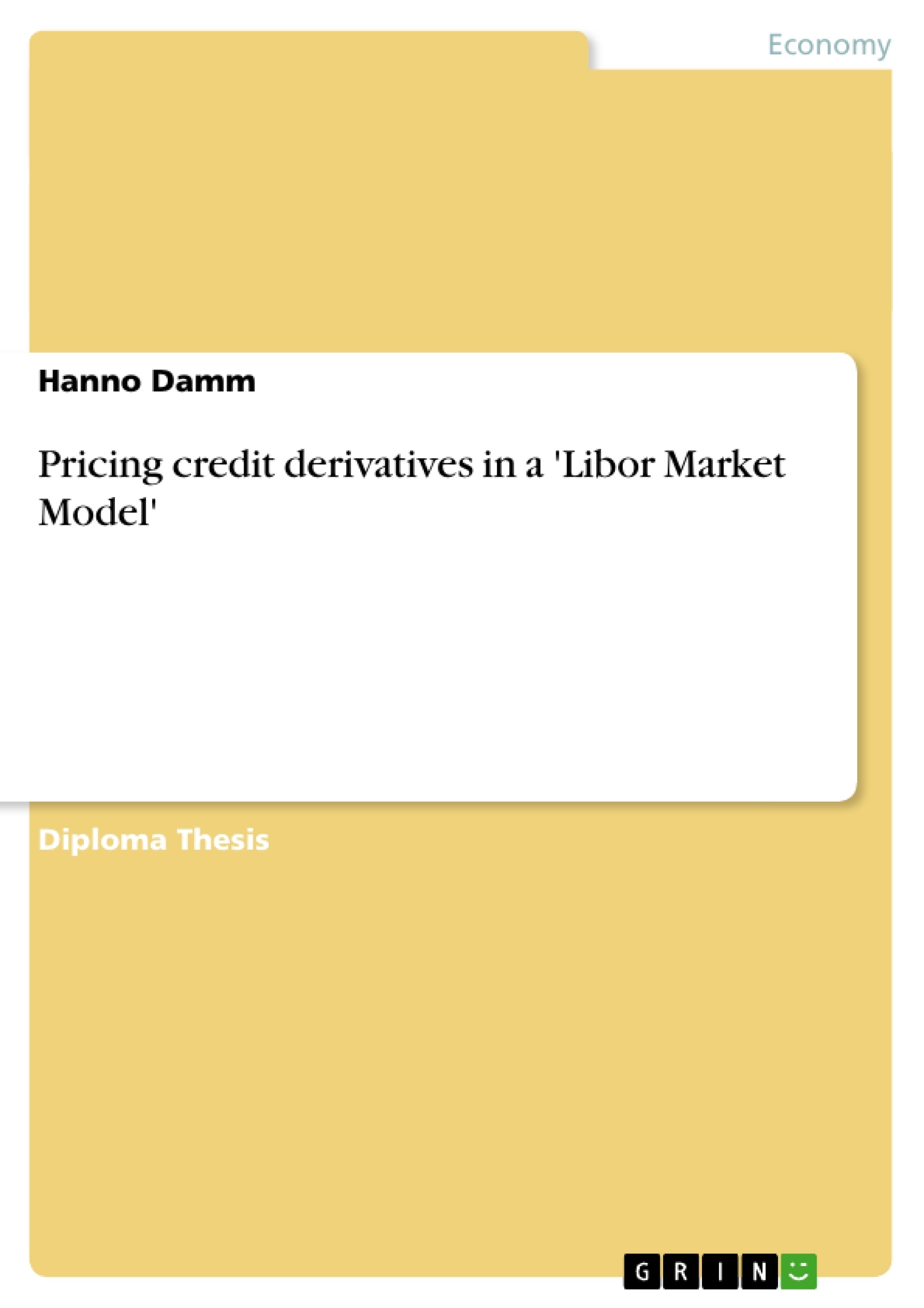The growing importance of credit derivatives creates the need to price them in a market consistent manner. In this thesis the well known and accepted Libor Market Model is extended following Schönbucher (2000). The thesis consists of two main parts: one describing and explaining the theoretical framework that will yield the pricing formulae for credit derivatives, and a second part explaining how to practically implement and calibrate the model. The second part also reports results of our implementation. We show that approximations introduced by Schönbucher (2000) hold and that the model can be used to price defaultable bonds, credit default swaps as well as options on credit default swaps.
The thesis has been written at the Department of Statistics, University of Bonn in cooperation with Deutsche Postbank AG Credit Risk Management.
Inhaltsverzeichnis (Table of Contents)
- Introduction
- I Theoretical Foundation
- 1 Modelling the Term Structure
- 1.1 Introduction
- 1.2 Libor Market Model
- 1.2.1 Motivation
- 1.2.2 Setup
- 1.2.3 Corresponding Heath-Jarrow-Morton Model
- 1.3 Change of Numeraire
- 1.3.1 Girsanov's Theorem
- 1.3.2 The T-Forward Measure Pk
- 1.3.3 Dynamics under the Terminal Measure PK+1
- 1.4 Pricing Interest Rate Derivatives
- 1.4.1 Caps
- 1.4.2 Floors
- 1.5 Conclusion
- 2 Modelling Credit Risk
- 2.1 Introduction
- 2.2 Default Risk in the Libor Market Model
- 2.2.1 Discrete Tenor Setup
- 2.2.2 Heath-Jarrow-Morton Background
- 2.3 Forward Measures in the Defaultable Market Model
- 2.3.1 The T-Forward Measure Pk
- 2.3.2 The Tk-Survival Measure Pk
- 2.3.3 Change of Measure from Forward to Survival Measure
- 2.4 Dynamics
- 2.4.1 Default Free Forward Rates
- 2.4.2 Defaultable Forward Rates
- 2.4.3 Forward Spreads and Intensities
- 2.4.4 Dynamics of the Default Intensities under the Terminal Survival Measure
- 2.5 Independence vs. Correlation
- 2.6 Conclusion
- 3 Modelling Recovery
- 3.1 Introduction
- 3.2 Valuation of Recovery Payoffs
- 3.3 Value of Defaultable Bonds
- 3.4 Conclusion
- 4 Pricing Credit Derivatives
- 4.1 Credit Default Swap
- 4.1.1 Valuation
- 4.1.2 Default Swap Rate
- 4.2 Pricing Options on CDS
- 4.3 Conclusion
- 4.1 Credit Default Swap
- 1 Modelling the Term Structure
- II Practical Implementation
- 5 Calibration
- 5.1 Introduction
- 5.2 Extracting Information from Market Data
- 5.2.1 Term Structure
- 5.2.2 Forward Rate Volatilities
- 5.2.3 Recovery Rates
- 5.2.4 Default Intensities
- 5.2.5 Intensity Volatilities and Correlation
- 5.3 Conclusion
- 6 Simulation
- 6.1 Setup
- 6.1.1 Dynamics
- 6.1.2 Random Numbers
- 6.2 Results
- 6.2.1 Credit Default Swaps
- 6.2.2 Default Payment
- 6.2.3 Pricing Options
- 6.3 Conclusion
- 6.1 Setup
- 5 Calibration
- Final Remarks and Outlook
Zielsetzung und Themenschwerpunkte (Objectives and Key Themes)
This thesis aims to develop a framework for pricing credit derivatives in a market-consistent manner. The author extends the well-known Libor Market Model to incorporate credit risk, building upon the work of Schönbucher (2000). The thesis is divided into two main parts: a theoretical foundation for pricing credit derivatives and a practical implementation and calibration of the model. The key themes include:- Extending the Libor Market Model to account for credit risk
- Developing pricing formulae for credit derivatives
- Implementing and calibrating the model using market data
- Simulating the model to assess its performance
- Analyzing the impact of default risk and recovery rates on credit derivative pricing
Zusammenfassung der Kapitel (Chapter Summaries)
- **Introduction:** Introduces the topic of credit derivatives and their increasing importance in financial markets. Outlines the thesis' objectives and structure.
- **Chapter 1: Modelling the Term Structure:** Introduces the Libor Market Model as a framework for modelling the term structure of interest rates. Explains the motivation for this model and its setup, including the corresponding Heath-Jarrow-Morton model. Discusses the concept of change of numeraire and its application in pricing interest rate derivatives.
- **Chapter 2: Modelling Credit Risk:** Introduces the concept of default risk in the Libor Market Model, explaining how to incorporate it into the model. Discusses the relationship between default risk and forward measures, and explores the dynamics of default-free and defaultable forward rates.
- **Chapter 3: Modelling Recovery:** Discusses the valuation of recovery payoffs in the context of credit derivatives. Explains how to account for recovery rates in pricing defaultable bonds.
- **Chapter 4: Pricing Credit Derivatives:** Presents pricing models for credit default swaps (CDS) and options on CDS. Explains the valuation of CDSs and the determination of the default swap rate.
- **Chapter 5: Calibration:** Details the practical implementation of the model, including the extraction of information from market data for the term structure, forward rate volatilities, recovery rates, default intensities, and intensity volatilities and correlation.
- **Chapter 6: Simulation:** Presents the simulation setup and results, including the simulation of credit default swaps, default payments, and pricing options.
Schlüsselwörter (Keywords)
This thesis focuses on the pricing of credit derivatives in a Libor Market Model. The key concepts and terms include: Libor Market Model, credit risk, default risk, recovery rates, credit default swaps (CDS), options on CDS, calibration, simulation, and market-consistent pricing. The study also utilizes concepts from interest rate modelling, including forward measures, Girsanov's theorem, and the Heath-Jarrow-Morton model.- Quote paper
- Dipl.-Volkswirt Hanno Damm (Author), 2002, Pricing credit derivatives in a 'Libor Market Model', Munich, GRIN Verlag, https://www.grin.com/document/54861



